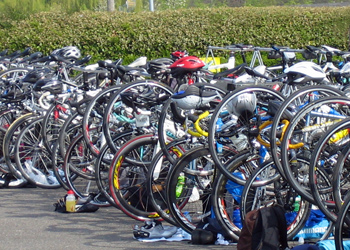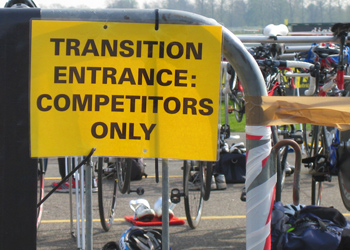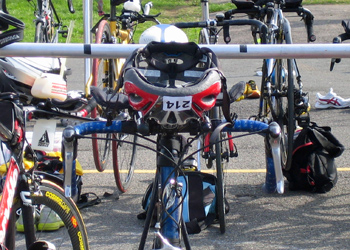Demystifying Triathlon Transition
You’ve trained for swimming, trained for cycling, gotten all of your running miles in… now, what are you forgetting? If you haven’t trained for transition, you’ve missed out on important training!

Transition is often called triathlon’s fourth discipline and for good reason. Transitions are the links between everything else. A good transition can save you time and energy, a bad one can cause you stress and even ruin your race. So what makes a good transition?
A good transition equals a fast transition, but a fast transition transition doesn’t always equal a good transition! In order to move quickly and effectively through transition, organisation is key. First of all, it is important that you haven’t forgotten anything that you need. A good way to ensure this is to refer to our race day checklist! Next, make sure that you arrive to your race in plenty of time to set up your transition.
At most races, you’ll register (get race pack, numbers, etc.) then head straight into transition, where you will have a space allocated to your race number. We like to mark our territory with a small towel, laying things out in the order that we need them. (Cycling items in front, running towards the back.) Make sure that your helmet strap is open, if you wear sunglasses, have them inside the helmet, ready to put on, shoes are loose and ready to slip your feet in. For your trainers, we recommend elastic laces or lace locks to allow for easy entry (and no worries about shoes coming untied!) Another helpful item is a race belt for your race number, allowing you to switch your number from back (for the bike leg) to front (for the run leg) without pinning and re-pinning.
 Leave extraneous items elsewhere. You need to see exactly what you need and be able to grab it quickly in what could feel like a high-pressure situation! Extra items will just add to the pressure and you often won’t be allotted enough space for anything extra anyway.
Leave extraneous items elsewhere. You need to see exactly what you need and be able to grab it quickly in what could feel like a high-pressure situation! Extra items will just add to the pressure and you often won’t be allotted enough space for anything extra anyway.
Once you’ve set up your transition, be sure to familiarise yourself with exactly where your space is located, perhaps by using a stationary landmark that will be easy to spot after your swim (i.e., under the big tree, three rows in). Don’t use another bike to do this – they may have left by the time you get out of the swim! Also familiarise yourself with where you’ll be entering after the swim, where you’ll leave on the bike, and where you’ll go out to begin your run. Trust us, this saves a lot of confusion during the race!
Even if your goal is to complete, not compete, it’s worth practising your transition (again, saving time and stress is paramount!). Set up your transition area at home. If you are doing a brick (swim/cycle or cycle/run) training session, work on changing from one discipline to another as quickly as possible. Practice getting shoes on and off and getting in and out of your wetsuit.

Speaking of wetsuits, we often hear from novice triathletes asking the difference between a trisuit and a wetsuit. A trisuit is a garment designed to be worn throughout your race and is comfortable under your wetsuit. A wetsuit is made of neoprene and meant only for the swim. As you will not be able to change fully in transition (there aren’t changing rooms and nudity is prohibited in transition!) it is recommended that you wear kit specifically for triathlon (a one- or two-piece trisuit).
For more transition tips, we recommend attending a Trigirl Training Day, where you’ll cover transitions and have the chance to ask questions of a qualified coach in a small group setting. You can also check out our YouTube video, Triathlon Transition Made Easy, for more helpful hints!